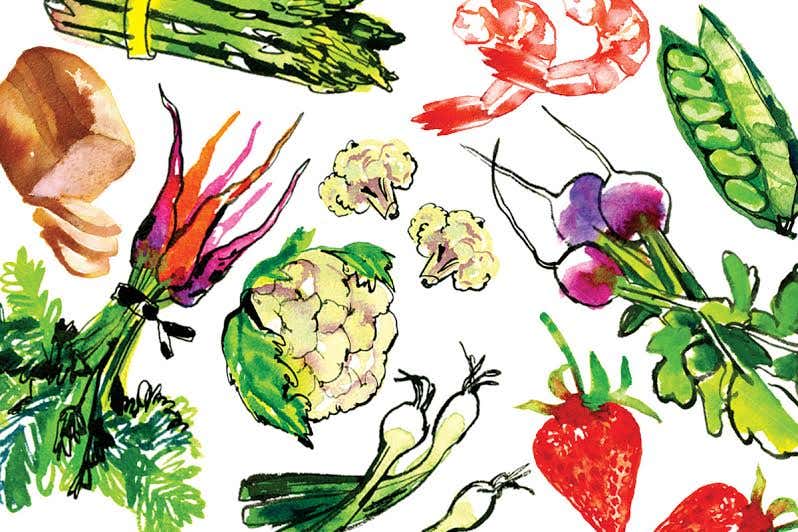
Roman À Chef
The details in Karen Hubert Allison's _How I Gave My Heart to the Restaurant Business _parallel so closely her real life as a New York restaurateur, and the book has so many easily identifiable food-world characters, that those who know who's who will be forgiven for wondering: Are the sex scenes true, too?
This mild send-up of the food world is, however, actually a lighthearted look at personal discovery, the story of a woman who can't earn a living from art (painting in the novel, poetry in the author's real life), but can and does from cooking. As her hobby becomes her business and as her business grows—as it did for Allison—from a quirky neighborhood bistro in Brooklyn to a big-name Manhattan mecca of fusion cuisine, she finds herself with everything and nothing.
In life, Karen Hubert made that leap with Len Allison, her affable, big-toothed, wiry husband, a former college English teacher; their acclaimed but now-closed restaurant was Hubert's. In her fictionalized version of the story, her heroine's rise from home cook to nationally acclaimed restaurateur is man-aged by ambitious, business-savvy Gunnar—a Russian-speaking Finnish hunk whose physical magnificence alone attracts media attention. Gunnar has "capitalism coursing through his veins like testosterone", cracks Allison's heroine, Kitterina Kittridge. There is, however, also testosterone aplenty. Although she often doesn't trust Gunnar's lovemaking, Kittridge never seems to tire of it—several steamy scenes _don't _take place in a kitchen.
There are recognizable food landmarks in the book: Jenks and Wollenska, "a veritable Museum of Modern Food", is undoubtedly Dean and DeLuca. The little Middle Eastern joint called It Pays To Eat Well, where the "babaganoush [sic] was as lavish as love", is the essence of several famously cheap restaurants on Brooklyn's Atlantic Avenue, near the author's first restaurant. What's even more provo-cative, though, is the fact that Allison's supporting characters are so clearly based on real people. On page one, Slav Czesny, an astrologer, foretells Kitterina's food-filled future; a real soothsayer named Alex Szogyi travels in New York's food circles. Next, a much more obvious and nationally known character enters. Kitterina, now nicknamed Kitchie, goes to work for the bullying Baron Bernard DeGroat, a blind food writer, in pursuit of the destiny predicted by Slav. Like the late, sightless Baron Roy Andries de Groot, DeGroat seems more respectful of his Seeing Eye dog than of his dutiful wife.
When Gunnar realizes that professional public-relations and marketing help are what he and Kitchie need to garner media attention, they hire Tom Bolognese, whose name brings to mind Bill Primavera—who, like Bolognese, specializes in staging commercial showcases in the guise of informational conferences. In the book, Bolognese recruits Kitchie and Gunnar to participate in the American Cold Cut Cornucopia in San Francisco; in real life, Primavera enlisted Karen and Len to participate in an American Lamb Council promotion in the same city. On a cruise associated with the fictional version of the event (there was a cruise for the real one, too), we meet the bulk of the funny food-business characters:
Michael O'Sullivan—"the Jack Nicholson of the food world…with his slicked-back hair"—is certainly Michael McCarty, of Michael's, in Santa Monica and New York. Lauren Dime, showing off the newest gadgets she discovered in Japan, must be Lora Brody, the bread-machine maven. "Stately" Millicent Nottingham is Marion Cunningham. Dixon Belvedere, who cooks cold cuts Creole-style to satisfy the promotional bent of the event, is obviously based on Paul Prudhomme. Dimitri Mozart, who "posed naked in the centerfold of an international cook's magazine" is definitely chef Jonathan Waxman—who years ago did in fact pose in a bathrobe for the cover of the New York Daily News Sunday Magazine. And the cynical, straight-talking, syndicated food journalist Nancy Greene is not Gael Greene, but unquestionably Suzanne Hamlin, who now writes for the New York Times.
Unfortunately, these characters aren't developed. They're just there to create a pivotal moment for Kitchie, who now finds herself falling into the money pit, losing her integrity, and losing sight of her real dream—a small cafe, with a breeze blowing through the kitchen window, where she can cook as she pleases. It's all very amusing, but would anyone appreciate this book if they didn't know who was who? Probably not. But now you do.
Keep Reading
Continue to Next Story










